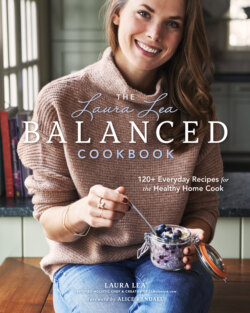Читать книгу The Laura Lea Balanced Cookbook - Laura Lea - Страница 27
На сайте Литреса книга снята с продажи.
ОглавлениеFIBER
Grains: Certain grains can be a wonderful
addition to a healthy diet. Grains are fiber-rich,
contain high levels of B vitamins for proper
metabolism and red blood cell formation, and
they’ve been shown to improve cholesterol
and blood pressure levels. I particularly love
oats, which I use throughout the book as a
gluten-free alternative to wheat flour (read
more about gluten next). That said, some
people experience irritable bowel syndrome
(IBS) symptoms when they eat grains. Grains
contain high levels of phytic acid, which we’ve
seen can inhibit nutrient absorption. They also
contain lectins, another plant self-defense,
which can interfere with digestion and trigger
an immune system response. If you eat grains
and experience uncomfortable symptoms, or
you see whole grains left in your stool after
elimination, they might not be an ideal part of
your diet. Besides oats, I only use a smattering
of grains throughout the book in the form of
white rice and quinoa. There are just so many
other amazing foods available! Feel free to
experiment with grains such as millet, barley,
rye, amaranth, or buckwheat if you know that
they agree with your digestive system.
Fresh vegetables: When it comes to the veggie
kingdom, it’s hard to go wrong. Barring any
specific health conditions, I say go to town on
plants, knowing that they’re one of our best
defenses against chronic inflammation. In
addition, very few foods can rival the nutrient
density of colorful vegetables, and their high-
fiber content is great for feeling satisfied,
aiding with digestion, and regulating blood
sugar. The veggie recipes in this book are
delicious and simple enough to convert even
the strongest skeptic, so I hope you’ll give
them a try.
• Cruciferous vegetables. This family
includes broccoli, Brussels sprouts,
cauliflower, kale, radishes, collard greens,
and cabbage, and they’re some of my
favorites when cooked properly. Cruciferous
vegetables have particularly potent anti-
inflammatory compounds.
• Leafy green vegetables. Kale has its own
empire for good reason, but so should
spinach, Swiss chard, bok choy, arugula,
and collard greens. Leafy greens are packed
with crucial antioxidants, which help
quell damage from environmental toxins,
chemicals in our body and beauty products,
stress, over-exercise, processed foods, and
medications. This class of vegetable is also
rich in the alphabet of vitamins—A, B, C,
D, E, K—and minerals, such as calcium,
magnesium, and folate. And let’s not forget
about the lettuce family, such as Bibb,
romaine, and butter lettuces, all of which
contain many healing compounds.
• Starchy vegetables. My absolute favorites!
Here we have jewel-toned beauties like sweet
potatoes, yams, and beets, winter squashes
like acorn and butternut, carrots, potatoes,
and parsnips. These veggies have a higher
sugar and starch content than others,
making them ideal candidates for roasting
and caramelizing. But they bring more to
the table than just flavor—they contain
a host of nutrients, insoluble fiber (which
helps create bulk in your digestive system
to push out waste), and soluble fiber
(a natural stool softener . . . no other way
to say it, guys).
• Allium vegetables. A.k.a., the smelly guys—
garlic, onions, scallions, leeks, shallots, and
chives all fit into this category. I say bring
’em on! The sulfides responsible for the
pungent aroma in these bulbous vegetables
